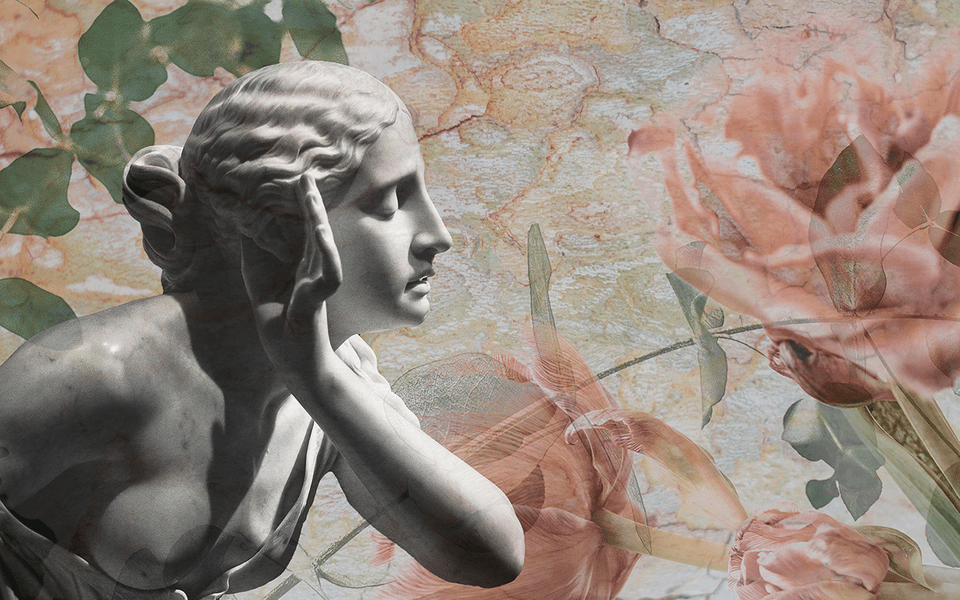
June 10, 2022, by Peter Kirwan
A Winter’s Tale (Scene Individible) @ The Door, Birmingham Repertory Theatre
It’s perhaps inevitable that a company based in Stratford-upon-Avon – a town plagued with living statues – would end up producing a play with two of them. Scene Individible’s company-devised A Winter’s Tale, created in response to a brief to talk back to Shakespeare, took advantage of the paradoxes of living statues: the stillness that is only revealed as art by the act of moving, the memorialisation of a static past layered on top of a living body. And in doing so, it offered an alternative Winter’s Tale (the deliberate A here doing significant work) that captured both the tedium of isolation and the pain of grief in the COVID age.
The play picked up where Act 3 of The Winter’s Tale leaves off. Paulina (Chloe Otterson) and Emilia (Ellie Cummings) carried the sleeping body of Hermione (Paige Calvert) into a greenhouse filled with pot plants that a hunched gardener (Curtis Dunn) had just been tending. As Hermione awoke, Paulina filled her in, reminding her of their shared plot to drug her in order to get her away from Leontes, a plan now in jeopardy following the death of Mamillius. Bravely, the production took on the impossible task of trying to render the pain of a mother learning anew that her son was, in fact, dead. And then, in flashes over sixteen years, the production traced Hermione’s life in isolation.
This is not a new idea; Mary Elizabeth Hamilton’s 16 Winters took a very similar approach to The Winter’s Tale in 2019 at the American Shakespeare Center. Post-COVID, however, the potential in Hermione living in isolation felt fresh. In some of the more promising sequences, Calvert wandered around the small room – now doing a few half-hearted step-ups, now trying to straighten out a measly bookshelf, then returning to the step-ups. In many ways, a bolder production would have leaned into this aspect much more strongly, developing and extending the rituals that keep people alive even while they deal with unimaginable loss.
Early on, Hermione took drapes off two plinths at either side of the stage, revealing grey statues of Mamillius (Erica Lowry) and Perdita (Kate Boleyn). These statues stood as silent presences for a long time, reminders of what had been lost. As the production went on, and the years began to stretch out, though, Hermione began to see them look at her, and then to move. As the years went on, the statues took on a life of their own, and Hermione lost herself in her imaginary motherhood as the two children ‘grew up’. The gardener, Time, pottered in the plants during these sequences, while an increasingly agitated Paulina attempted to pull Hermione out of her reverie, to bring her back to life.
The idea was great, but surprisingly, for a production whose dramaturgical note by Kyara Hunter made heavy weather of needing to resist Shakespeare’s dominance, the production was much too timid about deviating from Shakespeare. The weaker first half merely retold the events of The Winter’s Tale through Paulina’s visits to catch Hermione up on events: a recapping of Leontes’ reaction to Hermione’s death; a mock séance where Paulina and Hermione attempted to contact Antigonus and tell him to take Perdita to Bohemia; the suspected and then confirmed loss of the ship and Antigonus, as discovered by Emilia (posted to Bohemia by Paulina to get news). The exposition, taking up a good half of the production, seemed unwilling or unable to imagine a story for either woman that wasn’t constrained by the events of Shakespeare’s play, despite the near limitless possibilities of a sixteen-year timespan.
This also meant that characterisation was limited to only what Shakespeare offered; indeed, the only actual event not prescribed by the text was a brief mention of Emilia getting married and moving away. This left Paulina, in particular, static, reduced in the second half to repeatedly coming in to try to get Hermione to break away from her delusions. Hermione’s story was much more interesting, as she used the avatars of her two children to indulge her fantasies of parenthood, to relive her memories of Mamillius, but also to process what had happened to her. Mamillius was not a perfect son – here, he began showing the same entitled cruelty towards women that his father would, and in the show’s most inventive writing, Hermione processed her own grief about Leontes’ treatment of her by admonishing her own son. The disappointment was that, her one scene of step-ups aside, Hermione wasn’t allowed to be anything other than a grieving mother, defined to exclusion by her losses. It seemed a shame to spend seventy-five minutes and sixteen years with these two women, and for them not to become more than their relationship to their husbands and children.
Notwithstanding, the production built to a moving close, as Pauline announced Perdita’s rediscovery, and a weeping Hermione bid farewell to the fantastical version of Perdita she had watched group up, and to Mamillius forever, the two returning to stone even as Hermione herself assumed the position of the statue. The most interesting implication – the question of whether the real Perdita could live up to the version constructed by Hermione over the years – was left tantalising hanging; matter, perhaps, for Another Winter’s Tale.
No comments yet, fill out a comment to be the first

Leave a Reply